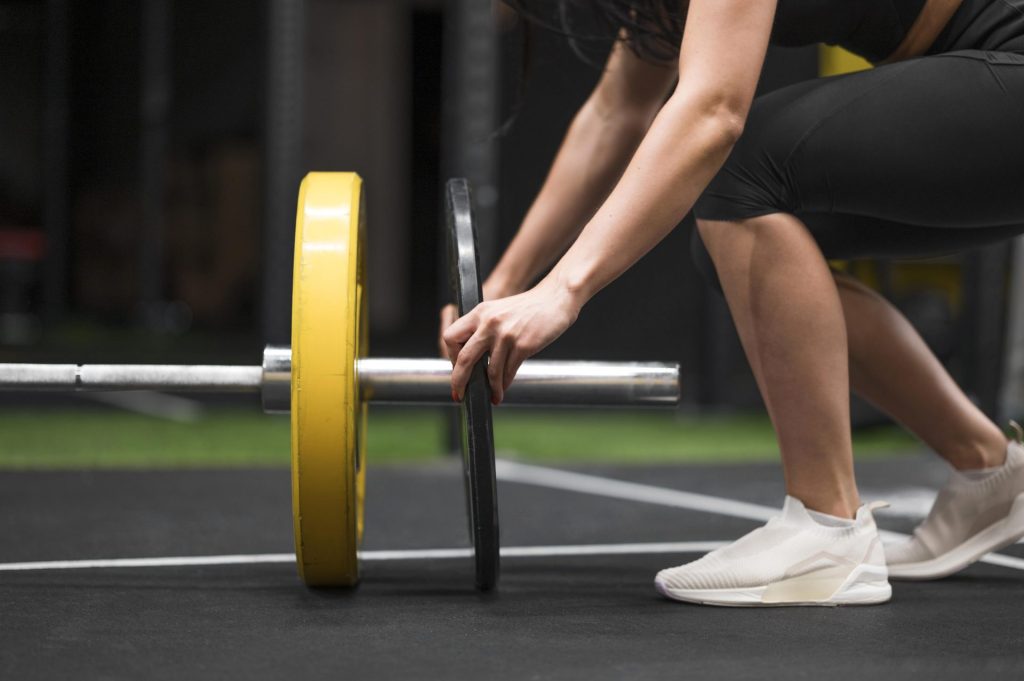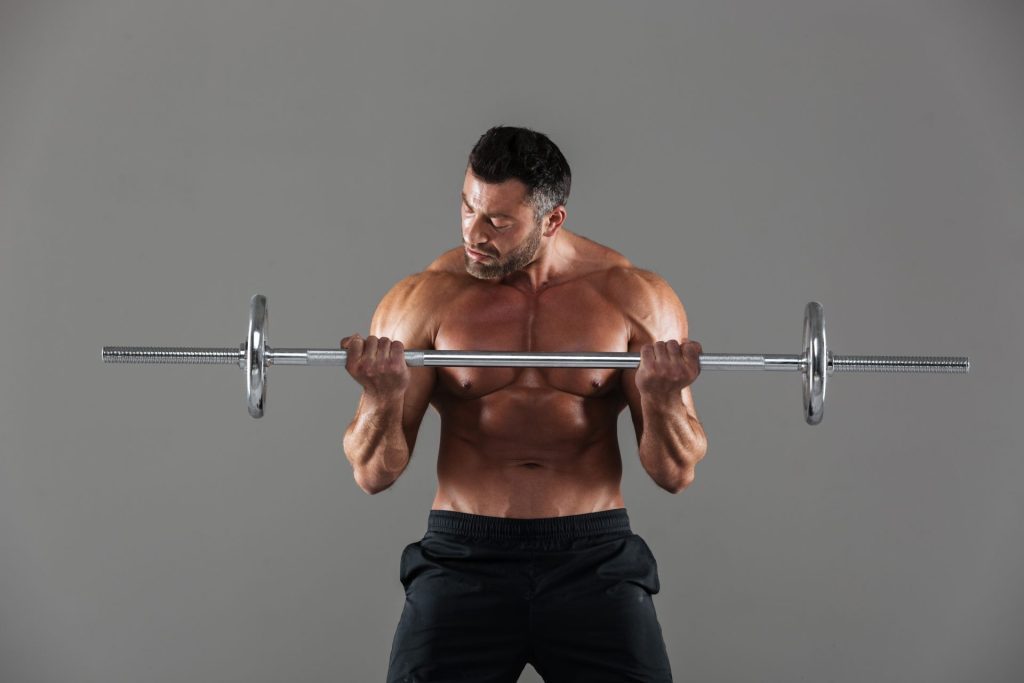Zercher Shrugs is an effective and interesting exercise for anyone looking to increase their overall strength. This old-school lift was popularized by strongman Louis Cyr in the late 19th century and was a favorite of bodybuilders like Steve Reeves, who used it to bulk up for film roles. Zercher shrugs to target your trapezius muscles, which move your shoulder up and down. They also help give you better posture and stability under heavy loads.
Best of all, they can be performed with minimal equipment, making them a great option if you’re short on space or don’t have access to a gym.
In this blog post, we’ll go over how to do Zercher Shrugs correctly, the benefits of this exercise, and the different variations you can use to progress and challenge yourself further.
Contents
What Is The Zercher Shrug?
The Zercher shrug is an isolation exercise that targets the trapezius muscles—more commonly referred to as the traps—in your upper back and shoulders. It also works your biceps, triceps, forearms, and grip strength.
TO PERFORM THE ZERCHER SHRUG, YOU START BY STANDING UPRIGHT WITH A BARBELL HELD IN FRONT OF YOUR CHEST USING A SHOULDER-WIDTH GRIP.
From there, you simply shrug your shoulders towards your ears while keeping your elbows tucked in close to your body.
As you do this, make sure not to lean too far forward or back; keep your posture neutral throughout the movement.
How To Do Zercher Shrugs Properly
When performing any type of weightlifting exercise, it’s important that you maintain proper form at all times in order to get maximum benefits from the movement and minimize risk of injury. Here are some tips for doing Zercher shrugs correctly:
- Place a barbell loaded with weights at your feet. Bend down and place your hands underneath the barbell so that your palms face up and your arms are bent at the elbows. You should be gripping the barbell with both hands between your legs.
- Keeping your back straight, lift the barbell off the ground until it reaches thigh level, then move it slightly forward towards your chest area as if you were performing a deadlift. Be sure to keep your elbows tight against your sides throughout this step as it helps to protect your lower back from strain or injury.
- Keep control of the weight while bringing it into position just above waist level by squeezing through your lats and glutes as you lift it up towards chest height; use only enough force so that you can maintain control of the weight throughout this step.
- Once you reach chest height, press through your heels and drive up onto your toes while pushing outwards using both arms for leverage in order to bring yourself into a standing position with arms extended overhead and palms still facing upwards; think of making an inverted “V” with your arms and body during this movement.
- Now start lowering yourself slowly by bending at the knees first before dropping down onto both feet again; make sure to keep control of the barbell’s weight during this step! Finally, carefully bend over again placing both hands beneath the barbell before finally setting it down gently on the ground once more.
- Repeat steps 1 – 5 for 3 sets of 8-10 repetitions per set (or whatever number works best for you). Make sure to rest the period in between each set by walking around or stretching out as needed before beginning another repetition round once more!
Benefits Of Doing Zercher Shrugs
There are many benefits to performing the Zercher shrug regularly; here are some of them:
- Improved Deadlift Performance – The Zercher shrug helps engage more muscle fibers to increase the total weight lifted during deadlifts. This can be beneficial for those who want to add more weight or break through plateaus during their deadlift routine.
- Increased Upper Body Strength – The Zercher shrug works several major muscle groups such as the traps, biceps, triceps, forearms, and grip strength all at once. This makes it an excellent exercise for increasing overall upper body strength.
- Improved Posture – Regularly performing the Zercher shrug can help correct poor posture by strengthening weak back and shoulder muscles, leading to better spinal alignment over time.
Variations You Can Try For More Challenge
1. Seated Zercher Shrugs
Seated Zercher shrugs involves performing traditional Zercher shrugs while seated. This variation helps to keep your core engaged throughout the exercise, making it more difficult than standard Zercher shrugs where you’re standing up.
To do seated zercher shrugs, sits on the edge of a bench, and hold a barbell in a zercher grip. With your chest up, pull your shoulder blades back while simultaneously raising your shoulders towards your ears. Squeeze at the top of the movement before slowly lowering down and repeating.
Be sure to keep good form throughout the entire exercise to maximize its effectiveness; this includes utilizing a full range of motion for proper muscular stimulation and lock-in abdominal control for safe execution of each rep.
2. Single-Arm Dumbbell Shrugs
With this variation, you’ll use a single dumbbell instead of two barbells to perform the shrug. This requires more stability in your shoulder joint since you’ll have only one hand gripping the weight. This variation also allows for a greater range of motion which can help to target different muscle fibers and further challenge your upper body muscles.
To execute this exercise, start by standing up with your feet shoulder-width apart. Grasp a single dumbbell in one hand and let it hang down at arm’s length. Without a pause or jerking, slowly raise your shoulder up towards the ceiling as far as you can go with no pain or discomfort.
Keep your core tight throughout, making sure that you are not arching your back in order to heighten the range of motion over time. When finished, slowly lower your shoulder before repeating for desired reps on both arms for optimal results.
3. Banded Zercher Shrugs
If you’re looking for an extra challenge with your shrugs, try adding a resistance band around your midsection before performing them. This will add extra tension to the movement, which can help to increase activation in your traps and other upper body muscles even more than with regular Zercher shrugs alone.
Utilizing a band during the exercise adds dynamic resistance that helps to increase muscular activation more than traditional exercises. Begin by attaching a looped resistance band around a power rack or hook at around thigh level.
Lie down in the center of the band with your chest supported by your elbows while you hold onto the two ends of the band— this is known as a Zercher position. Once you’ve settled into this position, use your shoulders to raise your arms up towards your ears in a controlled manner until you have fully shrugged them.
Then, slowly lower them back to their starting position for one rep before repeating until you have completed your set. Proper form must be maintained throughout in order for this exercise to be maximally effective; focus on keeping tension on the band and prevent any jerking motion or hunching at the shoulders, as this can cause injury.
4. Reverse Grip Shrugs
Unlike traditional Zercher shrugs requiring an overhand grip on the barbell or dumbbell, reverse grip shrugs involve using an underhand grip instead.
This variation puts more emphasis on the biceps and forearms as well as increases recruitment of the traps and other upper back muscles due to its more challenging nature compared to the traditional overhand grip Zercher shrugs.
5. Weighted Shrug Jumps
For those looking for an even greater challenge with their shrug movements, weighted jumps could be just what they need!
To perform this variation, simply grab two barbell plates (or two dumbbell weights) and jump onto a box or bench while holding onto the weights in front of you just like with a standard upright row exercise.
This will not only work your entire upper body but also engage your core muscles since they need to be activated during jumping exercises like this one.
Conclusion
To conclude, Zercher Shrugs are a great exercise for those looking to build their traps, lats, and upper back. Although the Zercher Squat can be difficult for some lifters, due to the lack of stability in the position, incorporating the Zercher Shrug into your routine can help you isolate your traps, lats and upper back without having to go too heavy.
The Zercher Shrug is also great for adding variety and changing up your workout routine. When done properly with good form and with a challenging weight load, this exercise will not only help to build strength, but also help you define areas like your traps that might otherwise lag behind other muscle groups.
So if you’re looking to add an extra challenge to your shoulder workout or simply want something new that can help you see results faster, give the Zercher Shrug a try!



